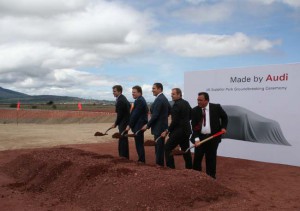Audi factory in Mexico breaks ground on new supplier park
Audi Mexico has broken ground on its JIS Supplier Park, a component suppliers facility expected to employ about 1000 people. The JIS Supplier Park is the latest addition to Audi’s upcoming production facility in San Jose Chiapa, Puebla, Mexico. 
The name JIS is an acronym of Just In Sequence manufacturing. Briefly, as vehicle bodies enter the assembly line, computers notify suppliers of what models are being build and in what order. Suppliers deliver parts required for those specific vehicle in the order that they proceed down the assembly line. The suppliers are given mere minutes to sort and in some cases assemble components required and make them available for installation. As part of the production tour we were able to visit the Puebla factory of an existing supplier for Audi in Europe, ThyssenKrupp, who also supplies the Puebla Volkswagen plant on a Just in Sequence basis. At this plant front axles are assembled and delivered with 144 minutes notice of the part being required at the installation point on the assembly line. Complicating matters are the many different models being assembled for different markets around the world. There is no margin for error in the supply chain as any errors on the assemble floor require that the line be shut down and the mistake be sorted at substantial loss of productivity.
In Audi’s case, the JIS supplier park currently has 7 firms approved as residents of the park, with more expected. Due to the close proximity essentially on the factory grounds, Audi can exercise tighter controls over its suppliers parts.
Dr Bernd Martens, a member of Audi’s management Board in charge of procurement was on hand to explain the way Audi intends to do business in its first North American assembly plant. Dr Martens revealed that the JIS facility will be a logistical and manufacturing facility for some companies supplying components for the second generation Audi Q5 SUV.
In addressing the Audi’s position as the first premium automaker to set up manufacturing in Mexico, Dr Martens explained Audi’s approach to choosing its suppliers for the next generation Audi Q5. Dr Martens stated that every Audi comes with the same promise of quality regardless of where it is built or sold. Audi not only inspects the supplier’s factory but follows its supply chain right back to sourcing its raw materials. Many of Audi’s suppliers already have facilities in Mexico given the growing auto sector in the country.
At present about 75% of all parts for the next generation Audi Q5 will be sourced within the NAFTA region, Audi expects to incrase that figure to 90% in the coming years.
At the 460 hectare Audi plant site, a number of steel framed buildings are still under construction. Audi expects its first building of the main factory, a training facility, to be complete by September 2014. At present resumes are being gathered from the towns surrounding the facility as well as in neighboring Puebla. Over 40,000 applications have been submitted and 500 workers have already been hired.
In the meantime, 400 new hires (both administrative and assembly) have been sent to Germany for training. One major component of the training is to learn the APS (Audi Production System). The APS is Audi’s Worldwide standard that manages all processes within the company. Once trained, these employees return and their knowledge will be shared with other employees. A total of 3,800 employees are expected to be employed at the plant with some additional 20,000 spin off jobs in the community.
Pre-production of vehicles is slated to begin in mid 2015. Full production models will be rolling off the assembly line by mid 2016.
Audi has committed to a total investment of about 1.3 billion US dollars to creating what is essentially an all-new industrial area in what was previously just corn fields. The Audi plant is about 40 kilometres away from the Volkswagen plant that was established over 40 years ago. The San Jose Chiapa site is strategically located along a the main rail line between Mexico City and the port at Veracruz. The infrastructure required to operate a modern auto assembly plant doesn’t currently exist and will have to be built. At present single lane roads are being replaced with modern multi-lane highways. Hospitals, schools, police stations and railway spur lines are being built to accommodate the expected increase in population and traffic. When questioned why go to these lengths to create infrastructure that already exists in the USA or Canada, Dr Martens stressed that while meeting NAFTA free trade requirements was an important factor, Audi was looking to a global export market with the second generation Q5. Audi’s commitment to Mexico was more strategically connected with the number of markets that Mexico had automotive trade agreements with. In fact, of the 150,000 vehicle slated to be built in the plant only 40,000 units will be allocated to the US or Canada, the remainder will be exported to Europe, South American and the Near East.
Copyright © Auto Reviews Online 2016 | Privacy & Terms of Use | info@autoreviewsonline.com | Website by Brolly Media
